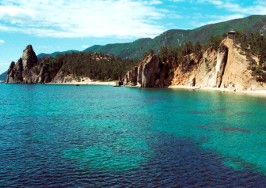
The word Baikal is derived from the Turkish Bai-Kul, which means "a rich lake" (compare: Is-syk-Kul - a warm lake, Kara-kul - a black lake). Some authors believe this word to come from the Mongolian Baigal (rich fire) or Baigal-Dalai (large sea).
Baikal is 31,500 square kilometers and equal to the area of such countries as Belgium, Nether-lands or Denmark. By its surface area Baikal ranks eighth among world's largest lakes. The total water volume on the Earth is about 1406 mln. cubic kilometers. Of them lakes and rivers contain 0.231 mln. cubic km. The volume of baikalian water mass is about 23.000 cubic kilometers. It is greater than the water volume contained in all five taken together Great Lakes in North America (Superior, Michigan, Huron, Erie, Ontario), in the Baltic, by 23 times greater than in Ladoga Lake. Lake Baikal contains one-fifth of the world's surface water resources (except ice of Antarctica, Green land and other glaciers), and four-fifth of fresh waters of Russia. Baikal is the deepest lake on the Earth. Its average depth is about 730 m. For the first time it was exactly calculated by G. Yu. Vereshagin in the 30's. The deepest known depth of Baikal (and lakes of the world) is 1637 m.

The coastline is 456 m above ocean level. The coastline is a boundary between land and water surfaces. On the map it is drawn along the line of an average little water level. The real boundary between land and lake - the edge line - is constantly changing due to water fluctuations.
Baikal is 20-25 mln. years old. But a modern shape Baikal acquired relatively recently, may be some million years ago. The total mineralization of the Baikal waters is 120 mg/l. The waters of Baikal belong to poorly mineralized soft waters. On average the share of hydrocarbonate calcium is about 84 %, chlorides and sulphates - 7 %, alkaline metals - 9 %. The chemical composition of wa-ter is comparatively homogeneous due to intensive mixing up. Baikal as a water body is filled up with surface waters. Rivers have no time to be saturated with salts, since crystalline rocks in their beds are difficult to dissolve, hence, they carry the water of poor mineralization into Baikal. The water has very high drinking qualities.
The Baikal world is extremely diverse. Now Baikal is known to have 1550 species and varieties of animals and 1085 species of plant organisms. In the open part of the lake the fauna by 60% is endemic. All in all, 11 families and subfamilies, 96 genera, uniting about 1000 species are endemic to Baikal. Out of 52 species of baikalian fish 27 species are endemic.
The most popular fish in Baikal is omul Coregonus autumnalis migratorius. Omul feeds upon zoop - lankton, bottom gammarids, larvae of insects and the young of fish. Omul spawns in the tributaries of Baikal in autumn. Maximum catches (the 40's) were 60-80 thousand tons. The omul population is subject to fluctuations due to intensive fishing and seasonal conditions of spawning.
The crowning glory and mystery of nature, Baikal was not created for production needs but for us to drink its water, its priceless and most important wealth, marvel at its stately beauty and breathe its precious air. First and for most, we need it ourselves.
You can find more complete description and photos of Baikal in websites:
http://baikal.ru/old.baikal.ru/baikal/bae_new.htm
http://www.sbaikal.ru/eng/baikal/index.htm
| 